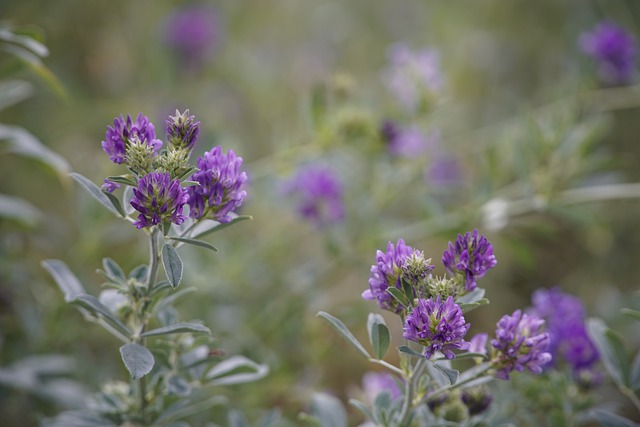 |  |  |  |  |
 |  |
The stems of lucerne are four-sided, bare or hairy, strongly branched at the top, grow up to 80 cm, can be upright, wide bushes or lying down. The rhizomes are strong, thick, deeply embedded in the soil, up to 10m. Leaves on petioles, 1-2 cm long and 0.3-1 cm wide, elongated inverted ovals with a smooth edge. The flower stalks come from the bazaars, longer than the leaves. Bunch of flowers in the shape of a head, dense, 2-3 cm long. Flowers blue-violet. Fruit - a pod cut in a spiral, with kidney-shaped seeds, up to 0.6 cm in size.
The surface part of the tissue is used for medicinal purposes. Collect during the flowering of the plant, in June-July. The stems and leaves are dried by spreading them in a thin layer (3-5 cm), in the fresh air, in a shaded place. Lucerne seeds is collected from the first harvest of plants. It is at this time that the pods contain 75-80% brown seeds. Freshly harvested seeds are cleaned, dried to 13% moisture and stored for up to 2 years.
Lucerne contain active substances: iron, phosphorus and calcium. The plant also contains vitamins A and C, unsaturated fatty acids, tannins, amino acids, phytoestrogens (coumestrol and henistein), cyclic compounds and saponosides.
Lucerne contain vitamins B1, B2, В12, С, D, Е, К, chlorophyll and amino acids. The concentration of vitamins and nutrients increases in the seeds during the ripening of the pod. lucerne leaves contain niacin, biotin, folic acid and pantothenic acid.Medicinal significance
Lucerne contains a lot of trace elements and contains a large amount of vitamin C, the plant has body-strengthening properties. Biologically active elements present in the plant (phytoestrogen stahydrin and 1-homostahydrin) regulate the menstrual cycle and increase lactation in women. Lucerne has a diuretic effect. Lucerne extract protects the skin from sunburn and radiation.
Lucerne is used in the period of exhaustion, body fatigue and post-diseases. Lucerne strengthens the elasticity of arterial walls, prevents the formation of atherosclerosis, stabilizes blood sugar levels, effectively reduces arterial pressure, has an anti-tumor effect, strengthens immunity and regulates the function of the pituitary gland.
In folk medicine, lucerne is used to treat excess weight, atherosclerosis, heart pain, ischemic heart disease, joint diseases, pain relief in arthritis, arthrosis, gout and rheumatism. Lucerne also helps with colds and bronchial asthma.
In case of liver intoxication, after illness, lucerne helps to cleanse the body of toxins and regain strength. The plant is also used for detoxification in the treatment of alcoholism. Lucerne can help with cramps, remove excess cholesterol from the body.
Lucerne is an effective remedy for constipation, acne, allergies and digestive tract diseases. The plant helps to remove uric acid from the body and normalize the water balance. Lucerne helps with bladder diseases, cystitis and nephritis. A decoction of the plant is used as a rinse for the treatment of trichomonad colpitis.
Lucerne improves the condition of diabetics and those with impaired thyroid and gall bladder function.
Lucerne contains enough vitamin K, which can reduce internal bleeding, which can be used in various forms of hemorrhagic syndrome, one of the causes of which can be radiation sickness.
Externally, Lucerne leaf powder is used to stop bleeding and heal wounds.
Just like mint, Lucerne improves appetite, for this effect it will be enough to boil alfalfa like tea. Lucerne contains a lot of fluoride, which allows Lucerne to be used to prevent caries.
